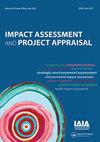瑞典十年生态连通性分析和城市规划经验
IF 1.9
4区 社会学
Q3 ENVIRONMENTAL STUDIES
引用次数: 7
摘要
摘要传统上,在城市规划中使用定量分析和相关指标来评估生态影响是不常见的。然而,自2010年以来,瑞典越来越多地在这种情况下使用定量建模来分析生态连通性。该研究基于17个标准对21份连通性分析报告(CAR)进行了回顾和分析。尽管使用了定量分析,CAR主要利用建模结果的定性方面。大多数CAR符合约50%的拟议标准,近90%的报告未能解决与建模透明度有关的一些问题,因此危及对结果的充分生态解释。研究结果表明,在过去十年中,主要成就是从业者和决策者对生态连通性的认识和接受度提高。结果表明,更多地使用定量方法本身不会带来更可持续的结果,在城市规划中更多地使用量化方法进行生态影响评估需要伴随着指导方针、标准和持续的科学与实践知识交流。本文章由计算机程序翻译,如有差异,请以英文原文为准。
Ten years of experience with ecological connectivity analysis and urban planning in Sweden
ABSTRACT The use of quantitative analysis and related metrics has traditionally been unusual for assessment of ecological impacts in urban planning. Since 2010, however, quantitative modelling has been increasingly used in such contexts in Sweden to analyze ecological connectivity. The study reviews and analyses 21 connectivity analysis reports (CAR) based on 17 criteria. Despite the use of quantitative analysis, CARs primarily leverage qualitative aspects of modelling results. Most CARs comply with about 50% of the proposed criteria and close to 90% of the reports fail to address some issues related to modelling transparency and therefore jeopardize an adequate ecological interpretation of the results. The results demonstrate that the primary accomplishment during the last decade is an increase in awareness and acceptance of ecological connectivity among practitioners and decisionmakers. Results point to that an increased use of quantitative methods per se will not deliver more sustainable outcomes, and that an increased use of quantitative methods for ecological impact assessment in urban planning needs to be accompanied by guidelines, standards, and a continuous science – practice knowledge exchange.
求助全文
通过发布文献求助,成功后即可免费获取论文全文。
去求助
来源期刊

Impact Assessment and Project Appraisal
ENVIRONMENTAL STUDIES-
CiteScore
4.60
自引率
22.70%
发文量
52
期刊介绍:
This is the international, peer-reviewed journal of the International Association for Impact Assessment (IAIA). It covers environmental, social, health and other impact assessments, cost-benefit analysis, technology assessment, and other approaches to anticipating and managing impacts. It has readers in universities, government and public agencies, consultancies, NGOs and elsewhere in over 100 countries. It has editorials, main articles, book reviews, and a professional practice section.
 求助内容:
求助内容: 应助结果提醒方式:
应助结果提醒方式:


